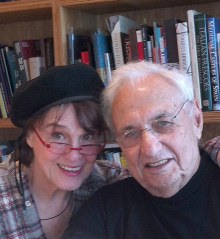
20131023_gehry.mp3
Click to the left to hear the architect of the new Jazz Bakery's beautiful new building talk about Disney Hall and his art. Thanks to KPCC's Offramp and John Rabe for the link.
The Walt Disney Concert Hall turns 10 years old. The venue opened on October 24, 2003, and quickly became the beloved home of the LA Philharmonic and its executive director at the time, Ernest Fleischman.
The gleaming $274 million building on South Grand Avenue in downtown LA was designed by Frank Gehry. Take Two recently paid Gehry a visit at his offices in West LA, where he explained that when it came down to a list of four architects, he was the only American on the list, and a definite underdog.
Now known worldwide for its trademark curves, it's nearly impossible to imagine anybody but Frank Gehry designing Disney Hall. One critic recently lauded the exuberance of the building's design and "The way it seems eager to expand outward like a bunch of balloons in a child's fist."
Gehry called it a sailing ship.
“I like the image of it as something moving. Our culture is so filled with movement compared to a hundred years ago. Everything is moving or flying," said Gehry.
The basic notion of the hall catered to the mixed population of Los Angeles.
“We wanted to build a hall that was open to everybody. Ernest [Fleishmann] wanted all the seats to be equal, which again is a wonderful thing to say, but some people had to sit behind the orchestra, some people had to sit on the side," said Gehry. "I think we succeeded in making it so that nobody felt second-class no matter where they sat. The space would encourage or generate intimacy and interaction. In other words, create a room that felt good to be in to listen to classical music.”
Due to the nature of the building, nearby apartments started to get 15 degrees hotter.
"It was a minor blip in the world, and then it became a major PR thing, and I still get asked about it, obviously. When you make a reflective surface concave, it has a focal point and when the sun hits it in the right place it will send a beam of heat into wherever. We analyzed all the shapes on the computer to eliminate that," said Gehry. "When it was built, accidentally two or three pieces of metal came together and they were placed wrong and they created that focus — a little bit of the steel wall was gone. It didn't merit appearing on the History Channel as one of the ten most, biggest engineering disasters of the decade."
On whether the Grand Avenue area will ever become a rival to the Champs-Élysées or Fifth Avenue, as Eli Broad imagines, Gehry is skeptical.
"I wasn't on board with that in the beginning, thought it sounded good, its not going to happen in my lifetime or his," he said.
